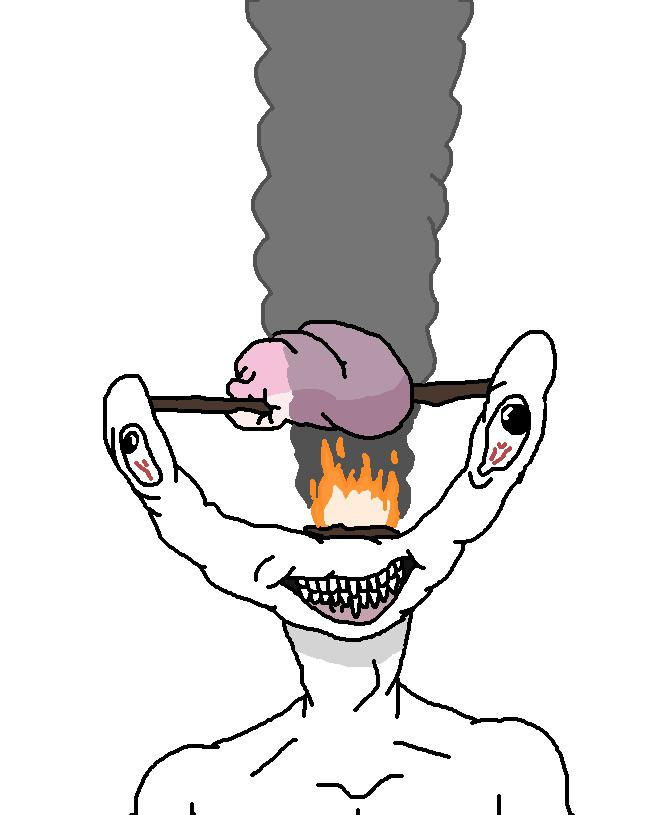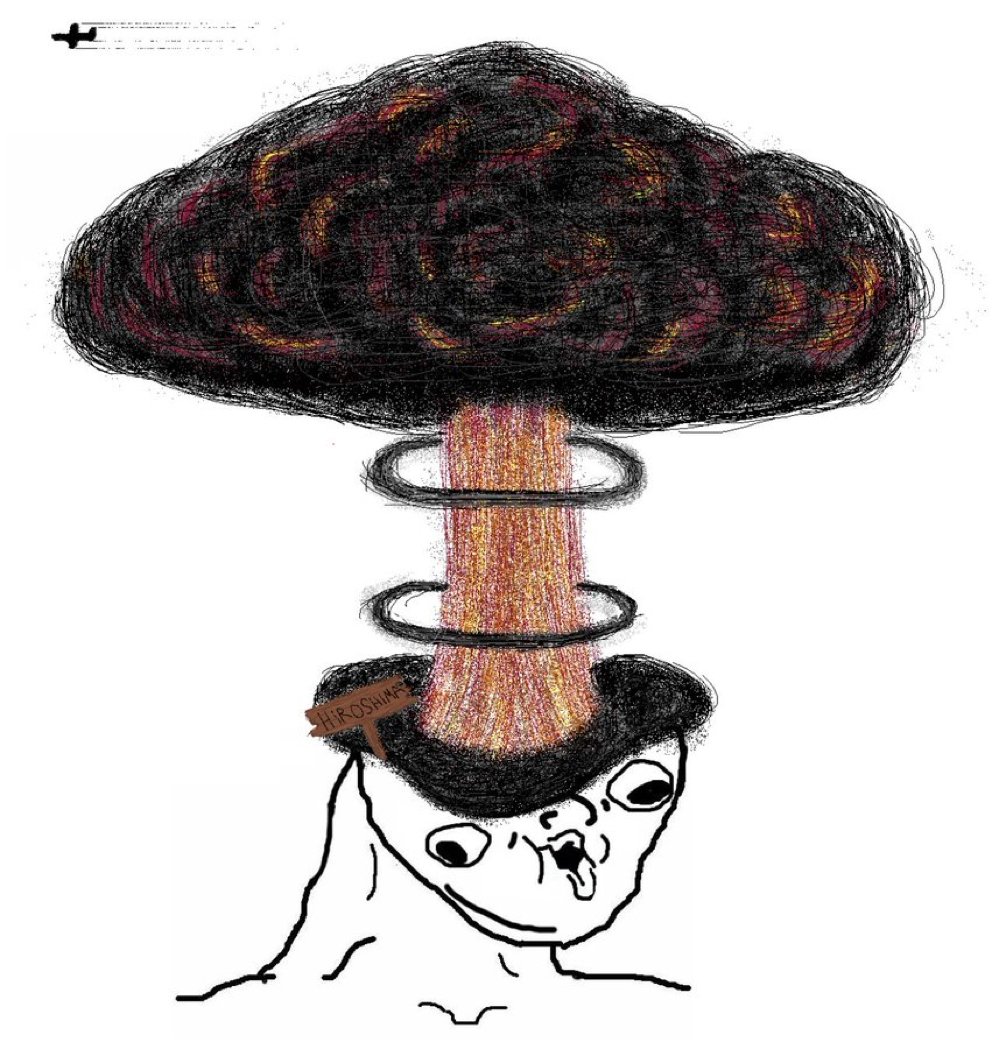Why Soyjaking Wins Arguments
Art by Tanzanian Wojak
Understanding the phenomenology of Soyjakian rhetoric.
We live in the age of argumentation.
As of the latest calculations, there are over 1.1 billion websites on the internet. A sizable chunk of them are media, opinion, and news sites. Week after week, essays and opinions are meticulously crafted to dispatch interlocutors with their razor-sharp logic. Sources are curated, synthesized, and employed to reinforce statements.
It’s admirable. I used to argue like this. I put loads of effort into forging my arguments to make sure angels themselves couldn’t pierce through my logic. But today, this effort is no better than wasted energy. It seems no one actually changes their minds post-Facebook. Rock-solid arguments are meaningless if they don’t take root in their targets. Another methodology of argumentation must be employed if one desires to win in the rhetorical colosseum; a method that cuts through the suit of baked-on layers of crusty pride and levies a lasting impact.
I stopped arguing with logic a long time ago after realizing this. Now, I soyjak to prove my point.
What many consider to be the first Soyjak, posted on November 19, 2017 in 4chan’s /v/ board.
Born from 4chan, soyjaks (often referred to as just “soys” or singularly “soy”) first appeared on the scene in 2017 as an offshoot of Wojaks. Wojak memes were around for nearly a decade before the first soyjaks emerged. Numerous ‘jak historians dispute the actual origin of soyjak; the most accepted “Out of Sweden” theory posits that the first ever soy was a .jpg file posted by a Swede, which depicted a traditional Wojak holding a Soylent bottle and sporting a navy-blue felt cap. This new soy-like Wojak was later adapted into the classic patchy-bearded, open-mouth soyjak most are now familiar with.
Soon, memers began to generate all kinds of soys: brainlet-soys, neckbeard-soys, and libtard-soys. Every modern-day stereotype imaginable was subject to the mockery of the soyjak. At the time of this writing there are millions of soys floating around the internet. Most normies at least know the Chad vs. Soy meme, which is hilarious in its own right.
An example of a soyjak vs. Chad meme, from Countere’s “How to Throw a Flat Earth Party.”
Since then, liberal Redditors can be found unleashing their frustration when they see an offensive soy. In r/Destiny, a subreddit dedicated for fans of a popular leftist YouTuber, a post titled “Conservative party in my country posts soyjak memes about people who care about climate change” contains volumes of comments from enraged users. One comment sarcastically reads, “Post a meme back where you're the chad, and they are the soyjak. That will show them!”
Likewise in the r/TheRightCantMeme subreddit, which makes fun of reactionary memes, someone posted a meme featuring a liberal-BLM-soygirl vs. a Chad-trad family. Among the many disgruntled comments, one said “Another fine addition to the Wojack Cope gallery”, suggesting whoever created the soy was coping in some fashion. But no one knew the creator of the soy. It was the soy itself that spawned their confliction.
Here the beauty of soyjaking interlocutors is revealed. Little do these Redditors know that their offense to the ‘jak indicates its effect. The Soyjakian method of rhetoric has deep roots in psychology.
When a new soyjak is created it is meant as a type of effigy, a caricature of a common stereotype. Soyjaks are made hyper-exaggerated. Many of the brainlet-soys feature brains roasting on fires and craniums hallowed out with bottomless pits to depict someone low in intelligence. Some atheist-soys are particularly hilarious because they match the stereotype perfectly, but using artistic hyperbole. One features a soy wearing a fedora, pointing his phone at you which has some secularist trope on it. My personal favorite is the Hiroshima-nuke-brainlet-soy.




However, this hyper-exaggeration is only an exaggeration to the creator or user of the soy. To the one taking offense to the soy, they do not see a hyper-exaggeration. They see a hyper-accurate depiction of what they truly are. The soy is hyper-real—it’s a condensed actualization of the truest self of the one who takes offense to it. The offender knows this. Their frustration arises from encountering their true self in the outside world.
Carl Jung (the founder of analytical psychology) would say the self is unmasked. Jung sheds light on how confronting the self isn’t easy by expounding on the reflectional properties of water: “Whoever looks into the mirror of the water will see first of all his own face. Whoever goes to himself risks a confrontation with himself. The mirror does not flatter, it faithfully shows whatever looks into it; namely, the face we never show to the world because we cover it with the persona, the mask of the actor. But the mirror lies behind the mask and shows the true face.”
Jung’s analogy is perfect. Here we can see the mechanism of how soyjaking destroys interlocutors from the inside out. The soyjak reflects the most inner part of those who take offense to them, which must then be destroyed, not because the soy is inaccurate, but because it is accurate. On a phenomenological level, the self is not encountered in everyday life. The self can be avoided, and is purposely avoided—hence the masks Jung speaks of.
When you put on a mask you play a trick on the outside world, but you also trick yourself. It’s a type of inner LARPing. Thus, a cognitive dissonance can easily be employed to avoid one’s demons and inner contradictions. Subjective phenomena (emotions, intuitions, moral thoughts, epiphanies, things of that nature) can be explained away ad hoc to avoid the reality that they might be something generated from the self. So in order to unmask someone, their self must be perceived in objective, real-time.
The realism of the soyjak does precisely this. The soyjak is a hyper-condensation of the victim’s truest form that has tried to bust through in their mind for so long—which they’ve run from willingly and knowingly—but was brushed aside with denial.
The aforementioned Redditor are prime examples of the soy’s rhetorical power. The Redditor who claimed the soyjak memers were “coping” by creating the soyjaks is “coping” themselves. If the Reddit took no offense, it would mean the self was not accurately depicted in the soy. But alas, the user’s pride was damaged. A chink in the armor was opened; all it took was an encounter with himself. The counter-attack only affirms the effect of the ‘jak.
One last example of soyjakian rhetoric is when I saw someone trying to call one of my friends a non-Christian on my Twitter timeline. In the Christian world, there's a stinking debacle over how Christians ought to interact with government and/or wield political power. My friend is one of those who think that Christians can, and ought, call government authorities to repentance. This line of political reasoning is new to many Christians, and he received knee-jerk reactions calling him a non-Christian, as if holding a certain political philosophy would anathematize him.
This was obviously a half-witted take. I could have replied that my friend is a baptized Christian who verifiably bears the fruit of living faith. But surely this wouldn’t have changed their mind about my friend. My counter-arguments would only reaffirm their stubbornness. In using an ultra rare buy-the-top-sell-the-bottom soyjak, I exposed them for what they already knew in their heart of hearts before typing out the tweet: that the tweet was void of the slightest ounce of sensibility. Below you can see their reaction.
As you can see, it’s hard to even make out what they’re saying. Something about the Talmud and Yoram Hazony? This is pure cognitive dissonance, observed in the wild.
If you’ve scrolled Facebook or Twitter for a few minutes, you understand that the most air-tight argumentation is futile today. We’re all shells trying to protect the pride. Our armor is made of the hardest steel. This is why soyjaking is the only way to win in the rhetorical colosseum. Indeed, in the internet-age, those with the deepest soy folder will have the best arguments.

